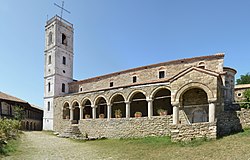Ardenica Monastery
| Manastiri i Ardenices | |
 |
|
| Monastery information | |
|---|---|
| Order | |
| Established | 1282 |
| Dedicated to | Byzantine victory on the Angevins in Berat during the Siege of Berat (1280–1281) |
| People | |
| Founder(s) | Andronikos II Palaiologos |
| Site | |
| Location | Fier District, Albania |
| Coordinates | 40°49′7″N 19°35′33″E / 40.81861°N 19.59250°ECoordinates: 40°49′7″N 19°35′33″E / 40.81861°N 19.59250°E |
| Public access | yes |
The Monastery of the Nativity of the Theotokos in Ardenica or simply Ardenica Monastery (Albanian: Manastiri Lindja e Hyjlindëses MariGreek: Ιερά Μονή Γεννήσεως Θεοτόκου Αρδευούσης) is an Eastern Orthodox monastery, distant 18 kilometers north of Lushnje, Albania, along the national road that links Lushnjë to Fier.
Built by Byzantine Emperor, Andronikos II Palaiologos in 1282 after the victory against the Angevins in the Siege of Berat, the monastery is famous as the place where, in 1451, was celebrated the marriage of Skanderbeg, the national hero of Albania, with Andronika Arianiti. In 1780 the Monastery started a theological school to prepare clerics in Greek Orthodoxy. It had an important library with 32,000 volumes that got completely burned by a fire in 1932. The Church of Saint Mary within the monastery contains frescoes from brothers Kostandin and Athanas Zografi, notably one of saint John Kukuzelis, born in Durrës, Albania.
Scholars claim that the Byzantine Emperor, Andronikos II Palaiologos started building the monastery in 1282 after the victory against the Angevins in the Siege of Berat. The chapel of Saint Trinity was already there, erected centuries before. A pagan temple, dedicated to Artemis had existed on the site before the chapel, and it is thought that the name of Ardenica stems from Artemis. The monastery site lies approximately 1 km from the Via Egnatia (a major 2nd century Roman road). On April 21, 1451 in this monastery was celebrated the marriage of George Kastrioti with Andronika Arianiti. The archbishop of Kanina, Felix said the mess in the wedding in the presence of all the Albanian princes, members of the League of Lezhë and the ambassadors of the Kingdom of Naples, Republic of Venice, and Republic of Ragusa. This is mentioned first by A. Lorenzoni in 1940.
...
Wikipedia
